Chapter 8:
TEACHING and LEARNING
Overview
The University of California provides its students with a rich learning environment created by faculty engaged in both teaching and academic research. Student learning at UC involves classes, seminars, and lab sections enhanced by collaboration with faculty and researchers. Through these activities, faculty and students engage in a learning process that helps develop critical thinking, communication, and problem-solving skills, as well as discipline-specific knowledge.
Educating students and the public
UC’s faculty are principally responsible for maintaining UC’s academic excellence and promoting student success. Undergraduate student retention, graduation rates, and measures of effectiveness are presented in chapter 3 and graduation rates and time to degree for graduate students are in chapter 4. This chapter focuses on the learning experience of UC’s undergraduate and graduate students, reporting what skills they have learned, their engagement with faculty and their peers, and satisfaction with their UC experience. A majority of both undergraduate and graduate students report improvement in academic skills. This chapter also reports on the composition and workload of instructional staff across different academic disciplines and professional programs.
Expanding learning opportunities beyond students on campus demonstrates the connection between the teaching and the public service missions of the University. UC Extension offers adult professional and continuing education programs to Californians and people around the world, as well as degree completion and re-entry programs for former UC students. Combined, these programs result in enrolling hundreds0 of thousands of Californians each year.
Promoting educational effectiveness
UC is committed to continuous improvement of instruction and employs a range of pedagogical and assessment strategies to enhance and support student learning. Campuses offer pedagogical development and training for faculty and teaching assistants to promote the use of evidence-based teaching practices and improve the quality of teaching and learning. UC’s teaching and learning centers and offices provide instructional development trainings to instructors every year, improving the quality of education for students in all disciplines across all ten campuses.
UC promotes educational effectiveness by supporting assessment of student learning. Assessment strategies include the development of program-level student learning outcomes and integration of evidence of student learning into academic program reviews. Programs across UC are undertaking curriculum redesign and improvement as a result of assessment work. Much of this aligns with the expectations of regional accrediting agencies, in particular the WASC Senior College and University Commission (WSCUC). As part of WSCUC accreditation, UC campuses assess five main core competencies of student learning: writing, oral communication, quantitative reasoning, information literacy, and critical thinking. Each UC campus posts its WSCUC accreditation reports online.
Innovative instructional offerings
UC faculty develop and teach an ever-expanding catalog of online courses and programs, expanding learning opportunities for UC and non-UC undergraduates, graduates, and professional students. Through the UC cross-campus enrollment system, UC provides undergraduates access to high-demand courses offered at other UC campuses, increasing flexibility and opportunities for degree completion.
For non-UC students considering matriculation at a four-year university or resuming their studies, UC offers for-credit online courses that may transfer to other colleges and universities. UC Online provides courses that span a wide range of disciplines. UC Extension offers online continuing education courses, professional certificates and post-baccalaureate programs for those seeking to advance their education and to enhance their professional skills.
In addition to online courses, UC leverages instructional technologies to enhance instruction and promote success. UC continues to develop and refine hybrid courses using multimedia resources, videos, podcasts, e-books, and other technology-based tools. UC follows best instructional practices to embed innovative technologies into course design and focuses on creating online and face-to-face learning experiences that encourage collaboration and maximize faculty-student and peer-to-peer interactions. Increasingly, UC courses utilize a flipped model of instruction, where lectures and other traditional classroom content are provided online, and classroom time is dedicated to group discussions, problem-solving activities, and other experiential exercises.
The largest gains in self-reported proficiency between freshman and senior years were in “understanding your field of study” and the “ability to design, conduct, and evaluate research.”
8.1.1 Self-reported proficiency levels, Universitywide, Spring 2022

University of California Undergraduate Experience Survey (UCUES) Data Tables, 2022 dashboard
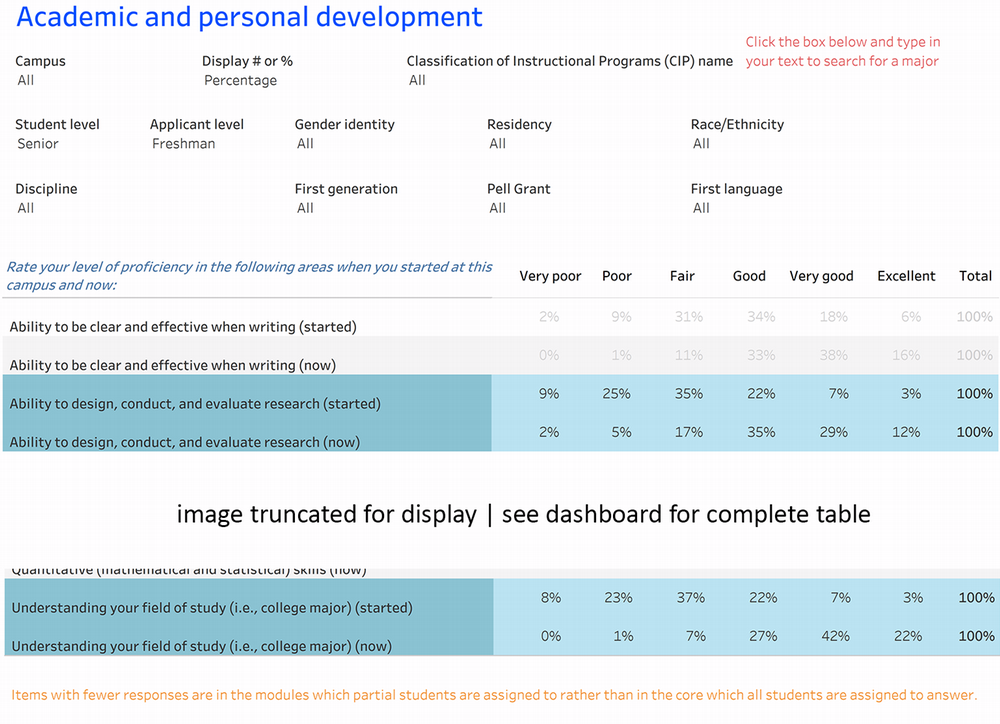
The Academic Development tab of the linked dashboard illustrates self-reported skill levels. To look at seniors who entered as freshmen, filter student level on “Senior” and applicant level on “Freshman.”
8.1 undergraduate student learning AND ENGAGEMENT
The Spring 2022 UCUES reports that 75 percent of bachelor’s degree recipients participated in research, internship, or service learning activities.
8.1.2 Students engagement with research, internships, and service learning, Spring 2022

UC undergraduate student research, internships, and service learning dashboard
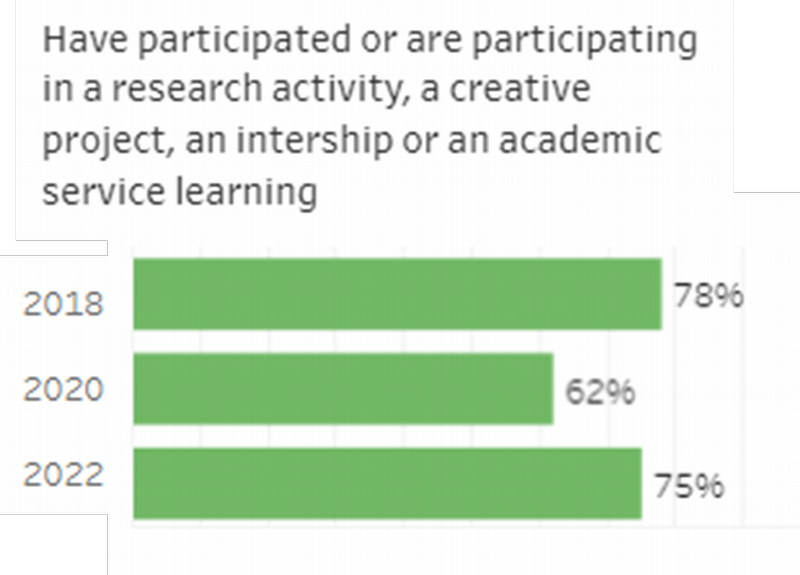
The dashboard provides detailed information on participating in research, internship, and service learning activities by campus, student demographics, and other categories. It shows a return to participation rates after a drop during the pandemic.
8.1 undergraduate student learning AND ENGAGEMENT
The Spring 2022 UCUES reports that 69 percent of students contributed to a class discussion at least somewhat often, while 44 percent at least somewhat often had a class in which the professor knew or learned their names.
8.1.3 Academic engagement, Spring 2022

University of California Undergraduate Experience Survey (UCUES) Data Tables, 2022 dashboard

Undergraduate student satisfaction increased in 2022 after declining for several years.
8.1.4 Student satisfaction, Spring 2006 to 2022

UCUES common item longitudinal analysis dashboard
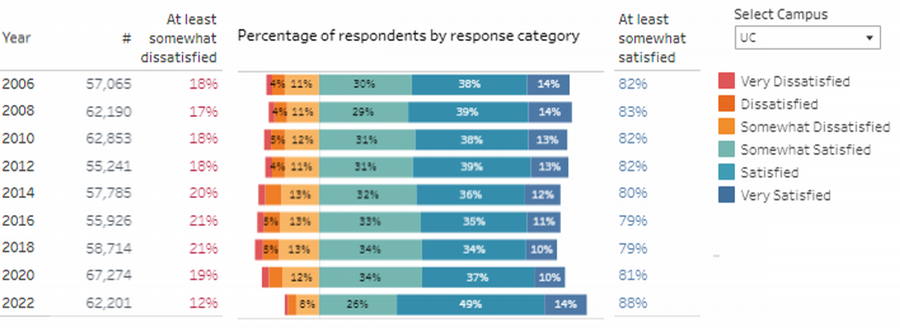 The UCUES common item longitudinal analysis dashboard provides trend data on critical items and the ability to filter by campus and other characteristics.
The UCUES common item longitudinal analysis dashboard provides trend data on critical items and the ability to filter by campus and other characteristics.
Online course-taking dramatically accelerated due to the COVID-19 pandemic.
8.1.5 Share of undergraduates taking at least one course online, Universitywide and comparison institutions, 2012–13 to 2022–23
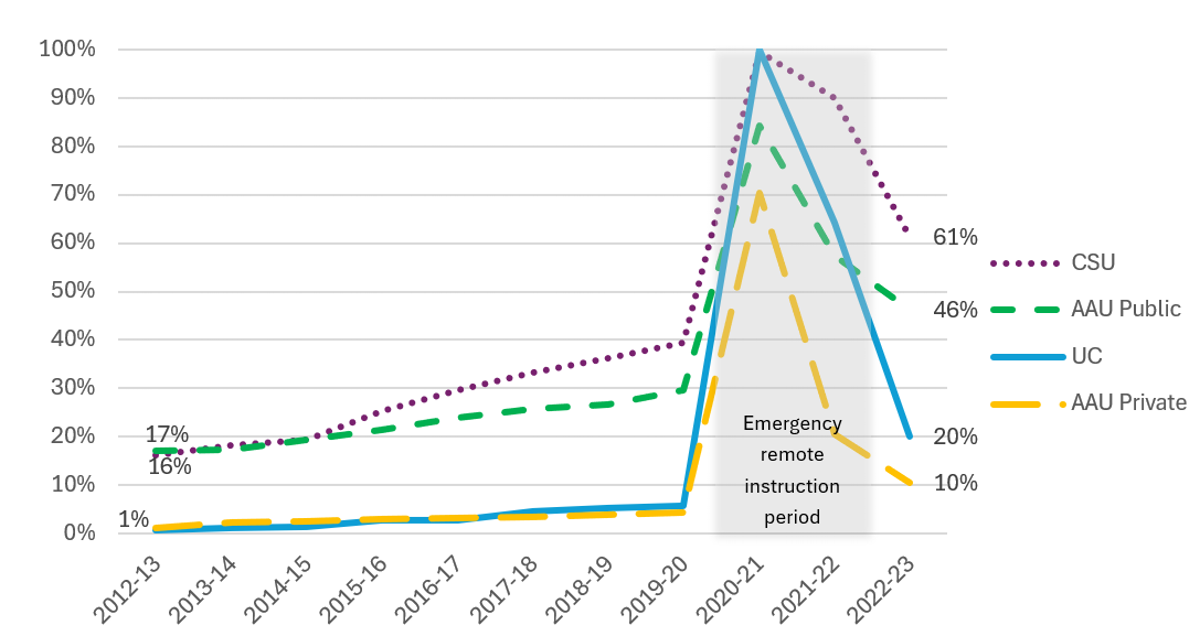
Source: IPEDS
In 2019–20, 3 percent of all undergraduate units, or approximately 279,000 out of 9.8 million, were delivered online. The Governor’s 2022–23 Budget proposed to double that number by 2030. In 2020–21, 96 percent of units were delivered online due to the COVID-19 pandemic. In 2022-23, 17 percent of all undergraduate units were delivered online.
Following a COVID-19 pandemic increase, the proportion of summer enrollment as a percentage of academic year enrollment has leveled off in 2021-22 and 2022-23 at rates slightly higher than prior to the pandemic.
8.1.6 Summer enrollment as a percentage of fall-winter-spring enrollment, Universitywide and UC campuses, 2009–10 to 2022–23
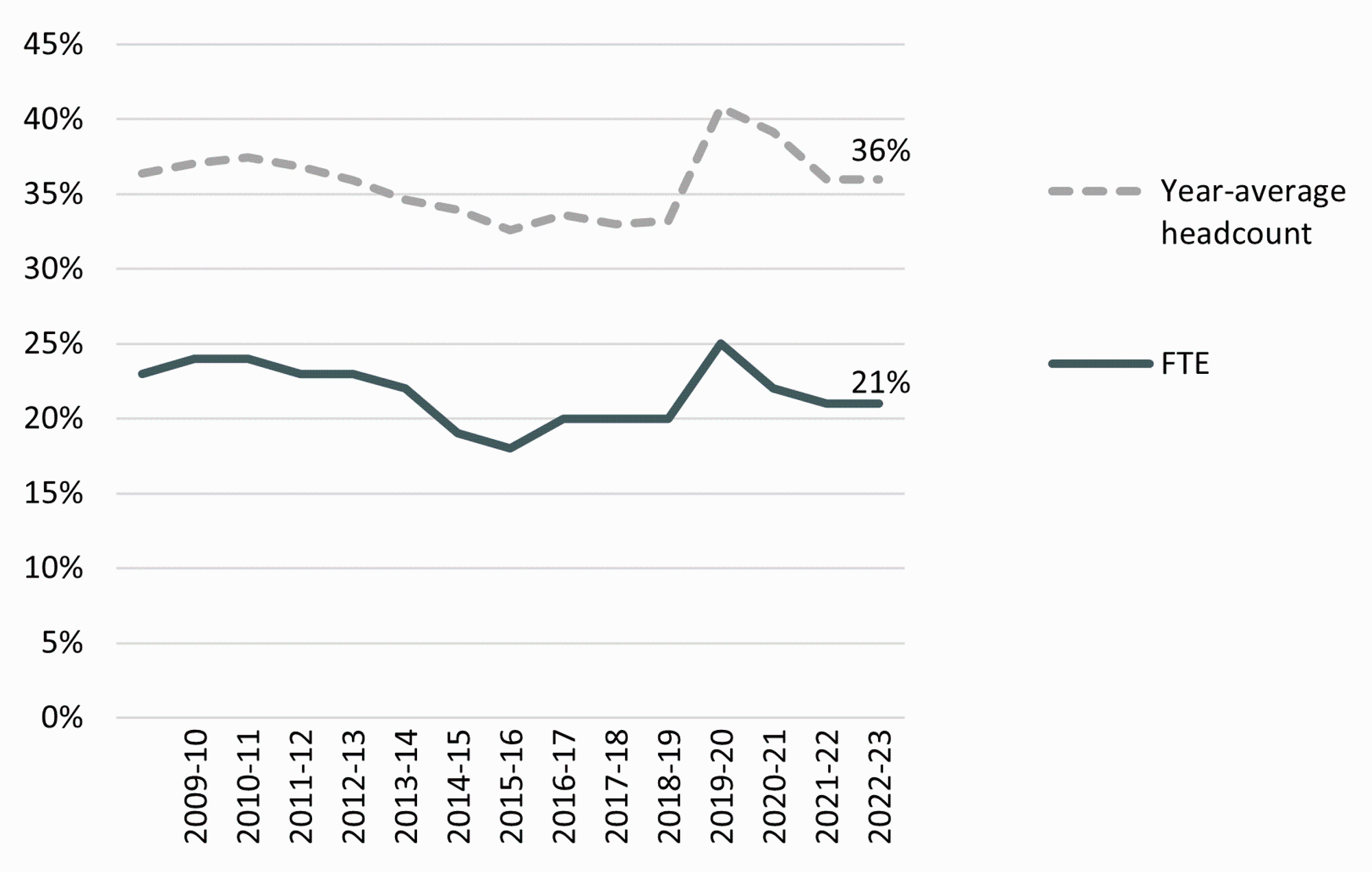
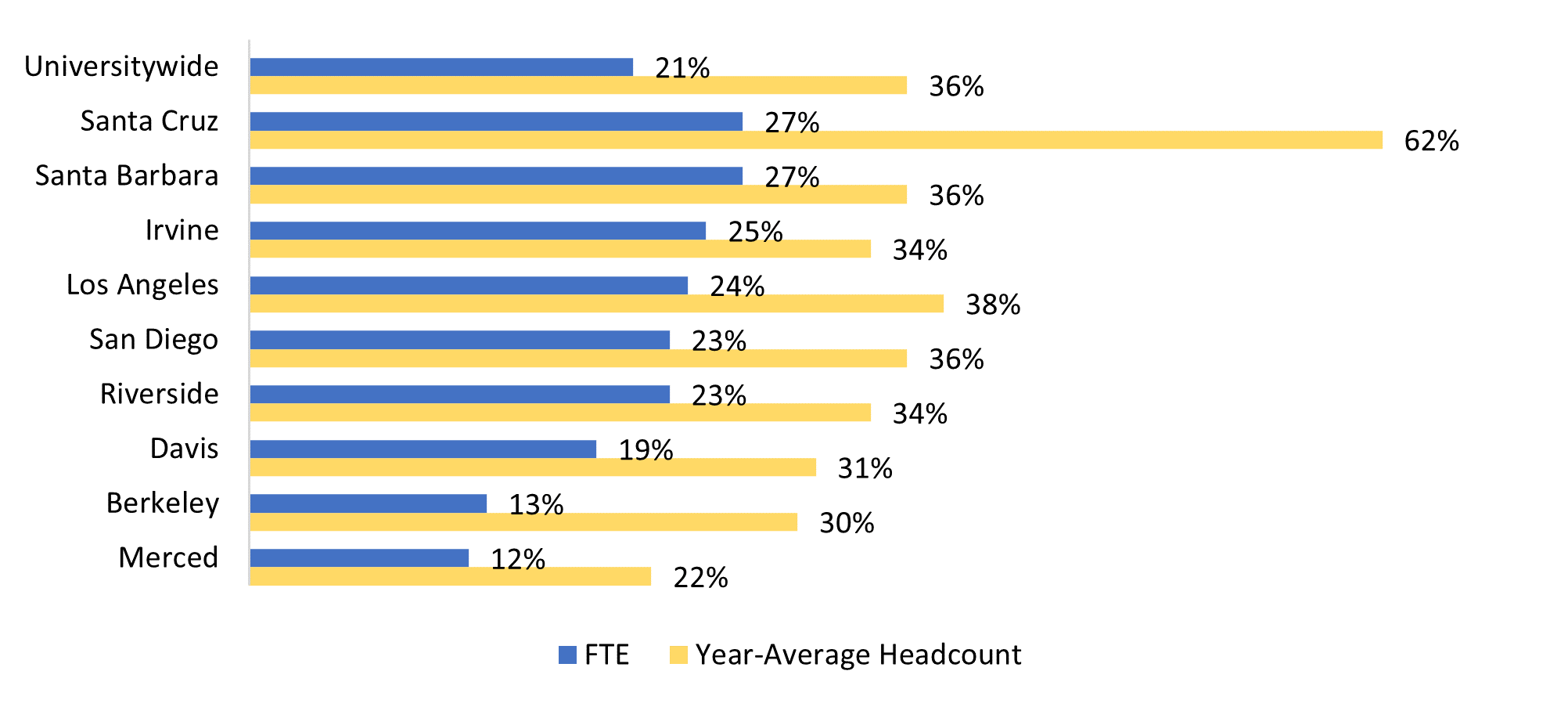
Source: Budget Analysis and Planning
For this indicator Summer is counted as a trailing term: e.g., the 2022–23 year includes summer 2023.
As shown in the linked dashboard, UC doctoral students credit their doctoral programs with having strengthened multiple skill sets.
8.2.1 Preparation by skillset, Universitywide, 2018 and 2019 combined

UC doctoral experience survey dashboard
How well prepared do you feel you are in the following skillsets?
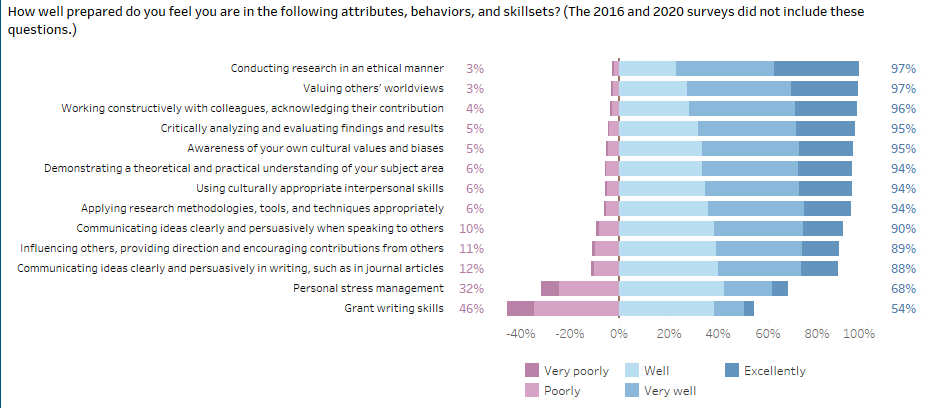
The Ph.D. Career Pathways Student Survey, a collaboration between the University of California and the Council of Graduate Schools, was administered in the spring 2018 and 2019 terms. The 2020 administration did not include items about skillset.
Over time, the student-faculty ratio has worsened, as faculty hiring has not kept pace with increasing student enrollment.
8.3.1 General campus student-faculty ratio, Universitywide

Student faculty ratio dashboard
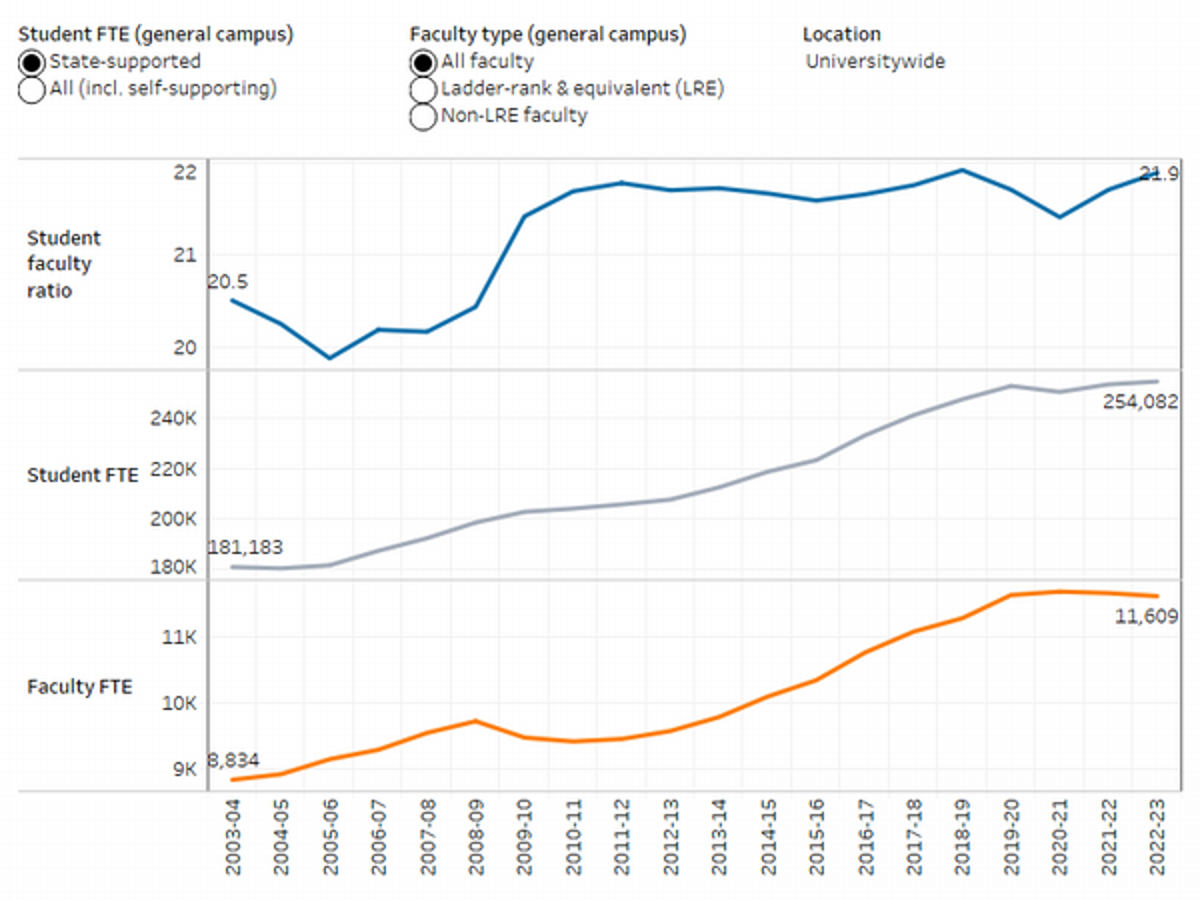
One measure of academic quality is the student-faculty ratio, which reflects resources available for instruction and the average availability of faculty members to every student. Thus, lower ratios are preferable for students.
Because the student-faculty ratio varies considerably by degree, major, and instructional level (lower-division, upper-division, and graduate), student experiences will vary as well.
Overall, a larger number of student credit hours are performed by full-time permanent faculty, meaning students have additional opportunities to be taught by leading scholars in their disciplines.
8.3.2 Student credit hours, by instructional staff and class size, Universitywide, 2011–12 to 2022–23

Source: UC Faculty Instructional Activities dataset1
Student credit hours (SCH) represent the number of student enrollments in a course multiplied by the number of credits earned from that course. For example, a four-credit class with 50 students generates 200 SCH; a two-credit class of 15 students generates 30 SCH. This measure gives an indication of the relative teaching load across different types of instructors at different levels of instruction.
Lower-division courses such as writing, language, and other required courses are most often taught by lecturers; introductory courses to the major are most often taught by full-time permanent faculty. Upper-division courses, which are core to the student’s major, are more likely taught by full-time permanent faculty, as are graduate courses.
1 Data are for general campus courses only. These data are submitted annually by UC campuses and contain information on all general campus courses taught in that year.
As students enroll in upper-division and graduate classes, they have greater contact with full-time permanent faculty and smaller classes.
8.3.3 Student credit hours, by instructional staff and class type and class size, Universitywide, 2011–12 to 2022–23
Lower-division classes (scale 0–1.8m)

Upper-division classes (scale 0–1.4m)

Graduate classes (scale 0–1.2m)

Source: UC Faculty Instructional Activities dataset1
1 Data are for general campus courses only. These data are submitted annually by UC campuses and contain information on all general campus courses taught in that year.
In the lower division, full-time permanent faculty generally teach large lecture classes; lecturers generally teach both large sections and smaller classes. In the upper division, student contact with full-time permanent faculty is fairly evenly distributed across classes of all sizes.
Graduate academic students are almost uniformly taught by full-time permanent faculty in classes with fewer than 50 students. The large enrollment increases in 2016–17 and 2017–18 resulted in a substantial uptick in SCH being offered in large lower-division lecture classes.
![]()












